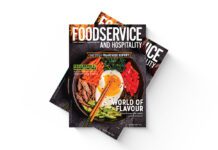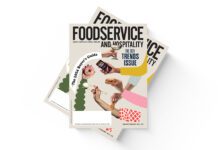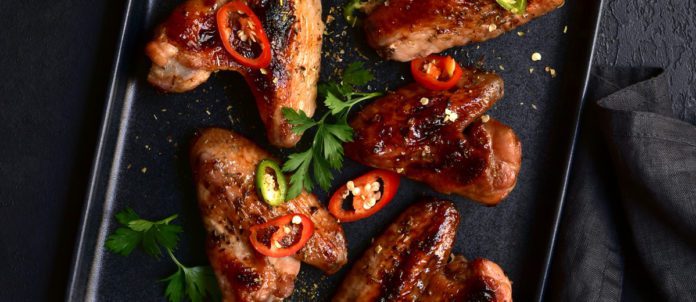Hands up if you haven’t indulged in takeout or delivery chicken recently. Barbecued, deep-fried, topping a pizza, stuffing a taco or filling a rice bowl, “the consumption of chicken continues to increase, and we see it as one of the top menu items overall,” says Robert Carter, industry analyst with The StratonHunter Group in Toronto.
Hot and Sweet
Last spring, South-Korean chain NeNe Chicken opened its first-ever North-American stores with two locations in Vancouver. It’s just one of many Asian brands that have been fuelling the demand for adventurous fried-chicken choices, with flavours such as sweet-chili sauce, “Hot Bling” sauce or cheese powder. Many of these fall under the popular category of “swicy” flavours (sweet plus spicy) that is also driving menu offerings such as hot pepper-honey pizza.
“We’re seeing that [trend] start to make waves,” affirms Lisa Bishop-Spencer, director of Brand and Communications for Ottawa-based Chicken Farmers of Canada (CFC), “savoury spices and heat plus sweetness, or an umami plus sweet: maple vinegar, honey vinegar. We’re going to see breaded chicken with sweet or umami notes, healthy with a side of indulgence.”
Bishop-Spencer also notes an interest in fusion concepts such as Korean tacos or Japanese ceviche. For example, in September, Mucho Burrito introduced its Tandoorrito, a Mexican-Indian combination of hot Tandoori masala and pico de gallo. There’s still demand for “nostalgic comfort-food classics,” but with “more flavours like peri-peri or smoke applewood, hickory. Europe is really seeing that right now,” she says.
“It’s about the flavour: cumin, ginger, influence from Asia and Middle-Eastern countries,” says Cinthia Nehring, international director of Marketing for Church’s Chicken, who is based in Toronto. Church’s Chicken brings in new items “every eight to 10 weeks,” such as a new garlic-herb option.
No End to Sandwich Wars
Piquant, indulgent and admirably adapted for takeout dining, the spicy fried-chicken sandwich has been one of the pandemic’s star performers, and there’s no sign that the QSR category’s “chicken-sandwich wars” are slowing down.
“The chicken-sandwich category is just exploding; it continues to have great traffic volume,” says Carter. Some chains, such as Church’s Texas Chicken, were ahead of the trend. “We’ve been doing sandwiches for over 15 years,” says Nehring. Its signature Mexicana is topped with spicy mayo, cheese, taco chips, diced onions, tomato and lettuce on a sesame bun. The brand has recently launched a Texas Dry Rub sandwich on a brioche bun.
Other outlets have been experimenting with related menu offerings; for instance, last August, McDonald’s launched a limited-edition run of its new habanero-powered Spicy Chicken McNuggets, the first tweak to its nuggets offering since 1984. These follow McDonald’s other peppery chicken innovations, including the Spicy Habanero McChicken (now a permanent menu item) and the occasional Jalapeño McChicken, Szechuan McChicken and Ghost Pepper McChicken sandwiches.
In September, Jollibee launched its Chickenwich, topped with umami mayo, and the Spicy Jollibee Chickenwich with sriracha mayo and fresh jalapeños. In mid-October, Popeyes added kick to its chicken sandwich and newly unveiled nuggets with Megan Thee Stallion Hottie Sauce, an on-trend sweet-hot blend of honey, cider vinegar and Aleppo pepper produced in collaboration with the vibrant Grammy-winning performer Megan Thee Stallion. Meanwhile, KFC brought back its Double Down for a short time in October and November, featuring bacon and Monterey Jack sandwiched not in a bun, but between two pieces of fried chicken.
Rapid Expansions
In 2021, Jollibee opened its third Winnipeg location and its third in Calgary, bringing the brand’s total to 22 stores in Canada. Hi Five Chicken, a 24-hour QSR chain that launched in Vancouver in 2016, is adding six more locations to its existing three. In Montreal, Portuguese rotisserie chain Piri Piri has plans to expand from five rotisseries to 25 by 2025 through franchising. The brand opened its first franchised store in November.
Also expanding are Mary Brown’s and Chick-Fil-A, while “St. Hubert in Quebec is such a strong brand staple, and they’ve expanded into the ‘quick casual’, as they call it,” says Carter. “Their new concepts continue to do really well.”
Although some previously successful businesses have faltered during COVID-19, “there are still going to be some really good chicken fast-casual concepts that will appear post-pandemic,” Carter says. With pre-cooked rotisserie chicken a number-1-selling grocery item, he believes rotisserie chicken still has a bright future, as well as “upscale fast-casual chicken places” ranging from Asian concepts to SoCal-style light and healthy menus.
And — more good news — the supply chain is healthy, says Bishop-Spencer. “Canada produces the vast majority of the chicken that Canadians consume,” she says, and “96 per cent of Canadians feel good about buying food from Canadian farmers.”
To capitalize on protein patriotism, she says, Chicken Farmers of Canada has recently re-launched its “Raised by a Canadian Farmer” logo in variations that reflect different standards of animal welfare, for use on menus and websites. The campaign ties the ongoing love of local together with the still-increasing interest in farming conditions.
But until the COVID-19 waves subside and dining-rooms are fully open again, the industry can count on an undiminished national enthusiasm for the comforting familiarity of chicken, livened up with a hit of flavourful condiments: a little bit of cheerful nourishment for both body and spirit.
By Sarah B. Hood


















